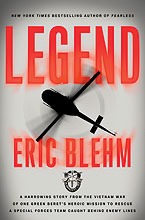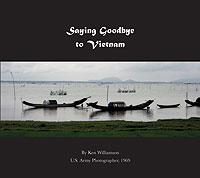 |
||||||||||||
|
Books in Review, July/August 2015 Eric Blehm on Roy P. Benavidez’s Courage Under Fire REVIEWS BY MARC LEEPSON
Few American soldiers performed more heroically in any war. Benavidez had been miles away from the fighting. But when he heard that his fellow Green Berets were surrounded and fighting for their lives, he boarded a helicopter to join the fray. He jumped out of the hovering helicopter straight into a hail of enemy fire. Benavidez then sprinted three-quarters of the length of a football field through the NVA lines to reach the men. During that mad dash he took a bullet to the leg and was peppered by RPG fragments. “Ignoring both the bullet and his shrapnel wounds, he crawled the remaining few yards into the beleaguered team’s perimeter, took control, provided medical aid, and positioned the remaining men to fight back the endless waves of attacking NVA while he called in dangerously close air support,” Eric Blehm writes in Legend: A Harrowing Story from the Vietnam War of One Green Beret’s Heroic Mission To Rescue a Special Forces Team Caught Behind Enemy Lines (Crown, 304 pp., $27), an excellent, evocative account of Benavidez’s life that focuses on the momentous events of May 2, 1968. As Blehm notes, Benavidez saved the lives of eight of the Green Berets during several more hours of intense fighting, which included hand-to-hand combat. He led the men onto a helicopter, then collapsed. Benavidez’s wounds were so severe and extensive that when the helicopter landed, a medic started to place him in a body bag. Blehm describes what came next. “The medic knelt over the body bag, rested his hand on Roy’s chest, and checked the pulse on his neck. ‘When I felt that doctor’s hand on my chest,’ Roy said, ‘with all the energy I could summon, I spit at him. Actually I sprayed a mixture of blood, spit, and mucus.’ “‘Stop!’ the medic said to a soldier about to pull the zipper shut. And the body bag was replaced by a stretcher.” Even though Roy Benavidez never fully recovered from his wounds, he stayed in the Army until he was forced to retire in 1976. The Pentagon had stonewalled Benavidez’s Medal of Honor nomination because there weren’t enough eyewitnesses to corroborate his actions in supposedly neutral Cambodia. In 1978, a newspaper reporter in Benavidez’s hometown of El Campo, Texas, wrote an article detailing what he did that day and calling for him to receive the MOH. The article was picked up by the Associated Press. Two years later, Brian O’Connor, a retired Green Beret living with his family in Fiji who owed his life to Benavidez, read the article. O’Connor picked up the cause and led a fight to get the retired sergeant the nation’s highest award for courage under fire. O’Connor, Blehm writes, “pieced together the torn and sometimes blurry snapshots from his memory, recounting the deaths of his teammates one by one, as well as the several helicopter rescue attempts beaten back by a determined enemy that was on the verge of overrunning their position.” O’Connor ended his first official statement about the incident with the words: “I caught a burst of fire in the abdomen and the radio was shot out. I was put out of commission and just laid behind [a] body firing at the NVA in the open field until the ammo ran out. I was ready to die.” The heart of the book is Blehm’s fine account of the battle action. He fleshes out the narrative with a short sketch of Roy Benavidez’s life before he joined the Army, and weaves in a solid accounting of Vietnam War historical background. The result is a readable, meaty narrative that tells the complete story of one of the most notable Medal of Honor recipients of the Vietnam War.
Saying Goodbye to Vietnam (Photo Gallery On the Net, 383 pp., $49.50) is the fulfillment of Williamson’s original thought. Four years in the making—but more than forty years in gestation—the book is a top-quality, one-of-a kind assemblage of hundreds of Williamson’s photos from his tour of duty, and his thoughts at the time, along with more photos and writing detailing his trips back to Vietnam in 1998 and 2004. As VVA Veteran editor Michael Keating (a fine photographer in his own right) has said, Ken Williamson “writes without hyperbole or self-aggrandizement about his tour in Vietnam, the challenges he faced as combat photographer, as well as his mixed feelings about the war and his longing for his wife and their newborn daughter.” The book is “quiet and serious,” Keating went on to say, “but never dull.” Williamson characterizes his book as “the story of my hour-by-hour struggle to make it one more day without losing my mind as I photographed the daily military events of the U.S. Army Engineers and the people of Vietnam.” He covers events chronologically, showing us a side of the Vietnam War that is seldom seen: the life of a military photographer who had to scrounge to set up his own darkroom and spent his tour of duty looking at the war, those who fought, and the people of Vietnam through his camera lens. “With this book,” he writes, “I have captured a slice of history about the Vietnam War as lived through my experiences and photography from a perspective not experienced by most military personnel.” As for his title, Williamson notes that Vietnam veterans “never say goodbye to Vietnam. It is impossible to say goodbye to the sights, sounds, and smells of a combat zone. These experiences stay with us forever.” Ken Williamson will be signing copies of his book at the VVA National Convention in Springfield, Ill. His photoessay, “Children of War,” appeared in the November/December 2014 issue of The VVA Veteran.
|
||||||||||||
|
|
||||||||||||
|
||||||||||||
8719 Colesville Road, Suite 100, Silver Spring. MD 20910 | www.vva.org | contact us |
||||||||||||
















